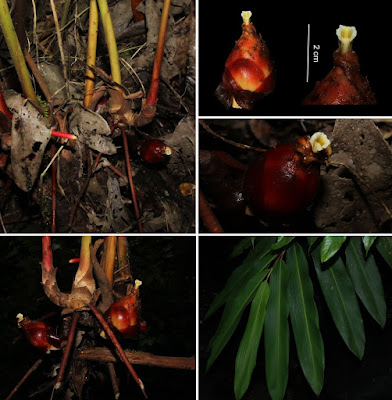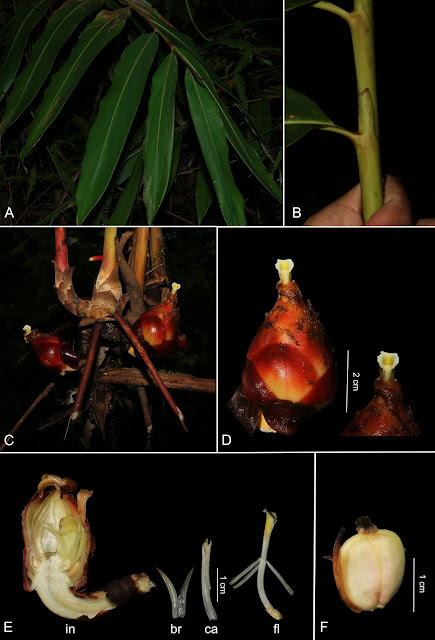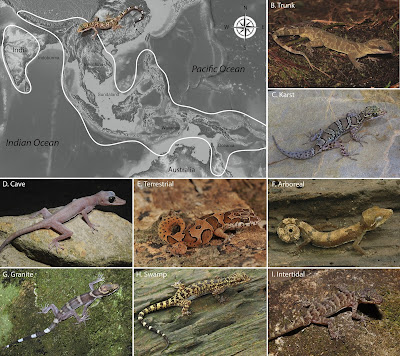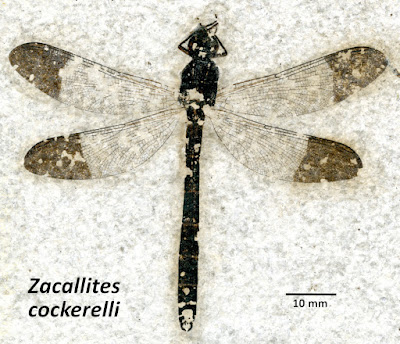[Most Recent Entries] [Calendar View]
Tuesday, December 1st, 2020
| Time | Event | ||
| 4:55a | [Botany • 2021] Etlingera dostseiana (Zingiberaceae) • A New Species from Mindanao, Philippines
Recent fieldwork on the island of Mindanao, Philippines resulted in the discovery of a species — Etlingera dostseiana Naive, Demayo & Alejandro (Zingiberaceae) — described here as new to science. It is unique among the Philippine Etlingera due to having an ovoid spike, papery bracts when fruiting, and stilt roots. A detailed description, photographs, phenology and habitat ecology of this endemic Etlingera species are provided. A total of 17 species of Etlingera are now known the Philippines, 11 of them endemic. This species is called Kating-kating by the Higaonon tribe in the Bukidnon Province, and the fruits were reported as edible (eaten as forest snack by the local people). So far the species can only be found in the island of Mindanao specifically in Bukidnon (type locality), Davao del Sur and Misamis Oriental. The specific epithet “dostseiana” was coined in honour of the Department of Science and Technology-Science Education Institute (DOST-SEI), for advancing and developing the Philippines human resource potential in science and technology by granting scholarships to undergraduate and graduate students. #ScholarNgBayan #dostasthrdp #DOSTsei #dostPH #zingiberaceae Naive M.A.K., Demayo C.G. and Alejandro G.J.D. 2021: Etlingera dostseiana (Zingiberaceae), A New Species from Mindanao, Philippines. Ann. Bot. Fennici. 58: 33–36. | ||
| 7:02a | [Herpetology • 2020] Evolution of Habitat Preference in 243 Species of Bent‐toed Geckos (Genus Cyrtodactylus Gray, 1827) with A Discussion of Karst Habitat Conservation Abstract Understanding the processes that underpin adaptive evolutionary shifts within major taxonomic groups has long been a research directive among many evolutionary biologists. Such phenomena are best studied in large monophyletic groups that occupy a broad range of habitats where repeated exposure to novel ecological opportunities has happened independently over time in different lineages. The gekkonid genus Cyrtodactylus is just such a lineage with approximately 300 species that range from South Asia to Melanesia and occupy a vast array of habitats. Ancestral state reconstructions using a stochastic character mapping analysis of nine different habitat preferences were employed across a phylogeny composed of 76% of the known species of Cyrtodactylus. This was done in order to ascertain which habitat preference is the ancestral condition and from that condition, the transition frequency to more derived habitat preferences. The results indicate that a general habitat preference is the ancestral condition for Cyrtodactylus and the frequency of transitioning from a general habitat preference to anything more specialized occurs approximately four times more often than the reverse. Species showing extreme morphological and/or ecological specializations generally do not give rise to species bearing other habitat preferences. The evolution of different habitat preferences is generally restricted to clades that tend to occur in specific geographic regions. The largest radiations in the genus occur in rocky habitats (granite and karst), indicating that the transition from a general habitat preference to a granite or karst‐dwelling life style may be ecologically uncomplicated. Two large, unrelated clades of karst‐associated species are centered in northern Indochina and the largest clade of granite‐associated species occurs on the Thai‐Malay Peninsula. Smaller, independent radiations of clades bearing other habitat preferences occur throughout the tree and across the broad distribution of the genus. With the exception of a general habitat preference, the data show that karst‐associated species far out‐number all others (29.6% vs. 0.4%–10.2%, respectively) and the common reference to karstic regions as “imperiled arcs of biodiversity” is not only misleading but potentially dangerous. Karstic regions are not simply refugia harboring the remnants of local biodiversity but are foci of speciation that continue to generate the most speciose, independent, radiations across the genus. Unfortunately, karstic landscapes are some of the most imperiled and least protected habitats on the planet and these data continue to underscore the urgent need for their conservation. Keywords: ancestral state reconstruction, Asia, ecology, Gekkonidae, limestone, phylogeny, stochastic character mapping L. Lee Grismer, Perry L. Wood Jr., Minh Duc Le, Evan S. H. Quah and Jesse L. Grismer. 2020. Evolution of Habitat Preference in 243 Species of Bent‐toed Geckos (Genus Cyrtodactylus Gray, 1827) with A Discussion of Karst Habitat Conservation. Ecology and Evolution. DOI: 10.1002/ece3.6961 | ||
| 10:24a | [PaleoEntomology • 2020] The Damselfly Palaeofauna (Insecta, Odonata, Zygoptera) from the Eocene of Wyoming and Colorado, USA
Abstract A new family, five new genera, and nine new species of fossil damselflies (Insecta, Odonata, Zygoptera, Calopterygida) from the USA are described, seven from the Eocene Fossil Lake deposits and one from Lake Uinta deposits, both from the Green River Formation, and an additional specimen from the Wind River Formation of Wyoming and Colorado. Namely, Carlea eocenica gen. et sp. nov. (in Carleidae fam. nov.), Labandeiraia riveri sp. nov., Labandeiraia browni sp. nov., Eodysphaea magnifica gen. et sp. nov., Litheuphaea sp. cf. coloradensis Petrulevičius et al., 2007, Zacallites cockerelli sp. nov., Dysagrion integrum sp. nov., Tenebragrion shermani gen. et sp. nov., Tynskysagrion brookeae gen. et sp. nov., and Oreodysagrion tenebris gen. et sp. nov. Epallagoidea and Amphipterygoidea are most common while Calopterygoidea, Coenagrionoidae and Lestoidea damselflies are less diverse. Genera of zygopteran Dysagrionidae are known from Europe and North America, further supporting the hypothesis of Palaeogene terrestrial interchange. Representatives of Epallagoidea and Amphipterygoidea in the Green River Formation confirm that warm conditions occurred at the time of deposition. Keywords: Zygoptera, Calopterygoidea, Epallagoidea, Amphipterygoidea, damselfly, Green River Formation Family ZACALLITIDAE Cockerell, 1928 Genus ZACALLITES Cockerell, 1928 Type species: Zacallites balli Cockerell, 1928. Other species: Zacallites cockerelli sp. nov. Günter Bechly, Romain Garrouste, Arvid Aase, Jered A. Karr, Lance Grande and André Nel. 2020. The Damselfly Palaeofauna from the Eocene of Wyoming and Colorado, USA (Insecta, Odonata, Zygoptera). Papers in Palaeontology. DOI: 10.1002/spp2.1346 | ||
| 10:52a | [Ichthyology • 2020] Riddle on the Riffle: Miocene Diversification and Biogeography of Endemic Mountain Loaches (Cypriniformes: Balitoridae: Bhavania) in the Western Ghats Biodiversity Hotspot Abstract Aim: The Western Ghats Hotspot in peninsular India harbours remarkable diversity and endemism of freshwater fish. However, the ichthyofauna's evolutionary histories and biogeography are poorly known. Here, we investigate (a) the diversity, evolutionary history and biogeography of endemic mountain loaches and (b) the potential influence of the physiography of hill ranges, geological barriers and river systems on the diversification and cladogenesis of loaches, in the Western Ghats Biodiversity Hotspot. Location: Southern Western Ghats mountain ranges (8–13°N latitudes), Western Ghats‐Sri Lanka Biodiversity Hotspot. Taxa: Mountain loaches Bhavania annandalei and B. australis (Cypriniformes: Balitoridae). Methods: We carried out a multigene phylogenetic analysis with mitochondrial and nuclear markers using Bhavania specimens collected throughout the genus' range. The Automated Barcode Gap Analysis, Poisson Tree Process and Generalized Mixed Yule‐Coalescent Model were used to delimit species. A Bayesian chronogram was constructed to estimate the time elapsed since the most recent common ancestor of the distinct lineages of Bhavania. Ancestral ranges of distinct lineages of Bhavania were reconstructed using the dispersal–extinction–cladogenesis model. Results: Phylogenetic analysis of combined mitochondrial and nuclear data, as well species delimitation using the Poisson Tree Process and Generalized Mixed Yule‐Coalescent Model analyses supported eight distinct lineages, which included the narrowly distributed B. annandalei and widely distributed B. australis. The Barcode Gap Analysis, however, supported only seven lineages. Bayesian divergence time dating suggests that the genus originated early in the Neogene and diversified in the Miocene. Ancestral state reconstruction indicated Bhavania diversifed as a result of sympatric, subset and vicariant speciation with five dispersal and one vicariant events across biogeographic barriers and river systems. Main conclusions: Bhavania australis is a ‘species complex’. Miocene‐associated climatic changes including intensification of the south‐west monsoon likely triggered dispersal and range expansion; subsequent aridification would have led to drying up of riverine connections, formation of land barriers and fragmentation of streams, resulting in cladogenesis. Our results also provide preliminary evidence that Cauvery, one of the largest east flowing rivers of Western Ghats, facilitates an east‐west pathway for dispersal and diversification of endemic lineages of the region. Keywords: Bhavania, biogeographical barriers, cryptic species, dispersal vicariance
CONCLUDING REMARKS Our multi‐locus phylogeny and divergence time dating suggest that the endemic WG mountain loach genus Bhavania originated in the early Neogene, and diversified/radiated into cryptic lineages in the Miocene. Facilitated by Miocene‐associated climatic changes including intensification of the monsoonal rains, Bhavania dispersed across the WG, expanding their range. Cladogenesis events were subsequently triggered by aridification and drying up of riverine connections, formation of land barriers and fragmentation of streams. Our results also provide the first evidence for Cauvery, one of the largest east flowing rivers of Western Ghats, facilitating an east–west pathway for dispersal and diversification of endemic lineages of the region. As a next step, a comprehensive family‐wide phylogeny of balitorid loaches including the endemic lineages of the WG, would certainly help improving our understanding of their current‐day diversity and distribution patterns, as well as the larger‐scale evolutionary and biogeographical history of hillstream freshwater fishes in the Indian Subcontinent, Indo‐China and the Sunda Islands. Arya Sidharthan, Rajeev Raghavan, Vasudevan Komalavally Anoop, Siby Philip and Neelesh Dahanukar. 2020. Riddle on the Riffle: Miocene Diversification and Biogeography of Endemic Mountain Loaches in the Western Ghats Biodiversity Hotspot. Journal of Biogeography. 47(12); 2741-2754. DOI: 10.1111/jbi.13972 |
| << Previous Day |
2020/12/01 [Calendar] |
Next Day >> |

























